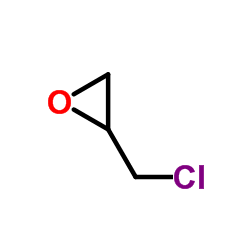Epichlorohydrin

Epichlorohydrin structure
|
Common Name | Epichlorohydrin | ||
|---|---|---|---|---|
| CAS Number | 106-89-8 | Molecular Weight | 92.524 | |
| Density | 1.183 | Boiling Point | 115-117 ºC | |
| Molecular Formula | C3H5ClO | Melting Point | -57ºC | |
| MSDS | Chinese USA | Flash Point | 28 ºC | |
| Symbol |




GHS02, GHS05, GHS06, GHS08 |
Signal Word | Danger | |
|
Bioluminescent liquid light guide pad biosensor for indoor air toxicity monitoring.
Anal. Chem. 87(7) , 3655-61, (2015) Indoor air pollution became a recent concern found to be oftentimes worse than outdoor air quality. We developed a tool that is cheap and simple and enables continuous monitoring of air toxicity. It is a biosensor with both a nondisposable (monitor) and dispo... |
|
|
Design of Zeolitic Imidazolate Framework Derived Nitrogen-Doped Nanoporous Carbons Containing Metal Species for Carbon Dioxide Fixation Reactions.
ChemSusChem 8 , 3905-12, (2015) Various N-doped nanoporous carbons containing metal species were prepared by direct thermal conversion of zeolitic imidazolate frameworks (ZIFs; ZIF-7, -8, -9, and -67) at different temperatures (600, 800, and 1000 °C). These materials were utilized as bifunc... |
|
|
The Xylella fastidiosa PD1063 protein is secreted in association with outer membrane vesicles.
PLoS ONE 9(11) , e113504, (2014) Xylella fastidiosa is a gram-negative, xylem-limited plant pathogenic bacterium that causes disease in a variety of economically important agricultural crops including Pierce's disease of grapevines. Xylella fastidiosa biofilms formed in the xylem vessels of ... |
|
|
Amphiphilic polyvinyl alcohol adsorbent for the removal of low-density lipoprotein.
Artif. Cells. Nanomed. Biotechnol. 43(2) , 117-23, (2015) Spacer can effectively reduce the steric hindrance and synergistic effect of the hydrophilic and hydrophobic ligands immobilized in adsorbents can improve the specific adsorption for low-density lipoprotein (LDL). In this paper, in order to improve the adsorp... |
|
|
Shell matters: Magnetic targeting of SPIONs and in vitro effects on endothelial and monocytic cell function.
Clin. Hemorheol. Microcirc. 61 , 259-77, (2015) Superparamagnetic iron oxide nanoparticles (SPIONs) are versatile and easily functionalized agents with high potential for diagnostic and therapeutic intravascular applications. In this study, we analyzed the responses of endothelial (ECs) and monocytic cells... |
|
|
Optimization, isotherm, kinetic and thermodynamic studies of Pb(II) ions adsorption onto N-maleated chitosan-immobilized TiO₂ nanoparticles from aqueous media.
Spectrochim. Acta. A. Mol. Biomol. Spectrosc. 154 , 145-56, (2015) Chitosan, CS was chemically engineered by maleic anhydride via simple protocol to produce N-maleated chitosan, MCS which immobilized on anatase TiO2 to synthesize novel eco-friendly nanosorbent (51±3.8 nm), MCS@TiO2 for cost-effective and efficient removal of... |
|
|
Kinetics of dextran crosslinking by epichlorohydrin: a rheometry and equilibrium swelling study.
Carbohydr. Polym. 92(2) , 1792-8, (2013) Curing behavior and gel properties of dextran are investigated during its crosslinking by epichlorohydrin (ECH) using rheometry and equilibrium swelling studies. Each ECH/anhydroglucose unit of different molar ratio (0.16-0.99) was added to a known volume of ... |
|
|
Optimized Treatment of Heparinized Blood Fractions to Make Them Suitable for Analysis.
Biopreserv. Biobank. 13 , 287-95, (2015) It has been known for decades that many cytokines, such as IL-2, IL-6, and IL-12, bind to heparin. Even though some enzyme-linked immunosorbent assays (ELISA) use antibody-recognizing epitopes not affected by this binding, ELISA manufacturers often warn that ... |
|
|
Hypericin-bearing magnetic iron oxide nanoparticles for selective drug delivery in photodynamic therapy.
Int. J. Nanomedicine 10 , 6985-96, (2015) Combining the concept of magnetic drug targeting and photodynamic therapy is a promising approach for the treatment of cancer. A high selectivity as well as significant fewer side effects can be achieved by this method, since the therapeutic treatment only ta... |
|
|
Adsorptive decolorization of methylene blue by crosslinked porous starch.
Carbohydr. Polym. 93(2) , 374-9, (2013) Crosslinked porous starch (CPS) was prepared by two steps. Native starch was crosslinked with epichlorohydrin and then CPS was prepared by hydrolyzing the crosslinked starch with α-amylase. As a biodegradable and safe adsorbent, CPS was used to remove methyle... |